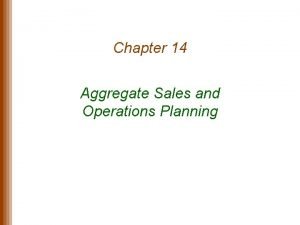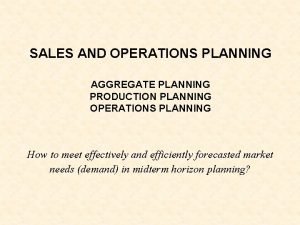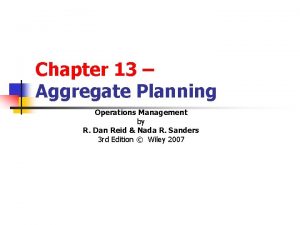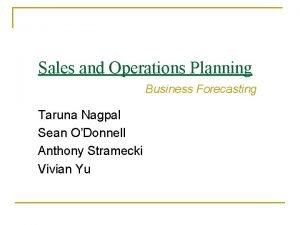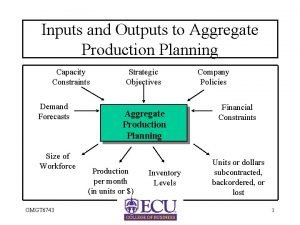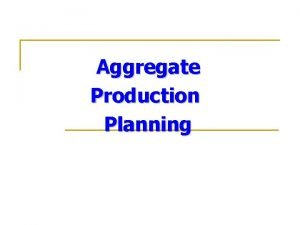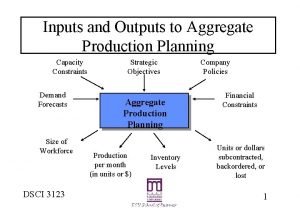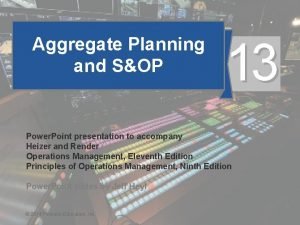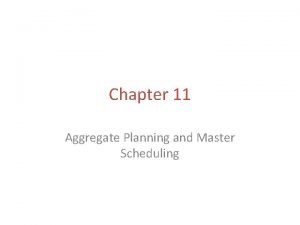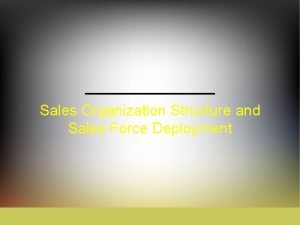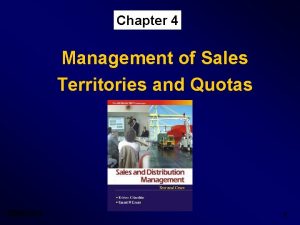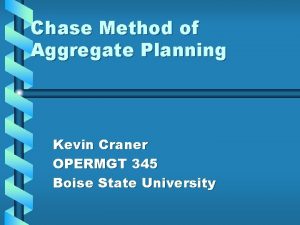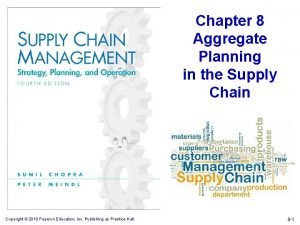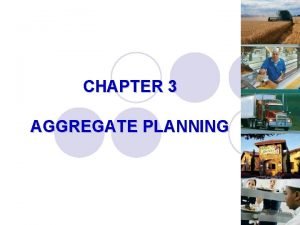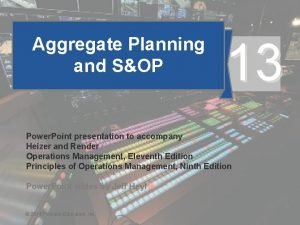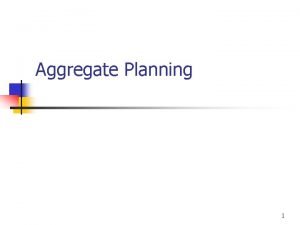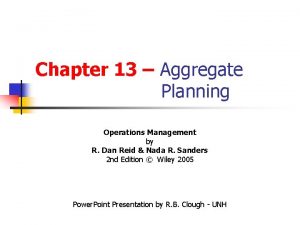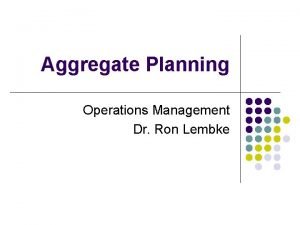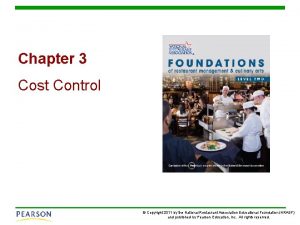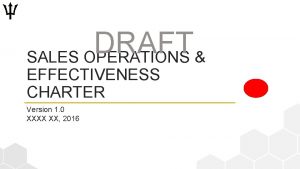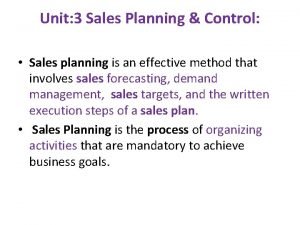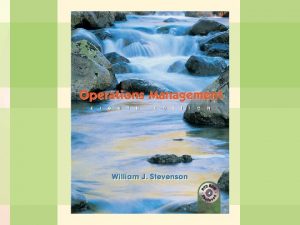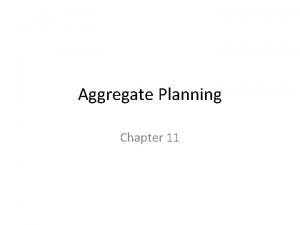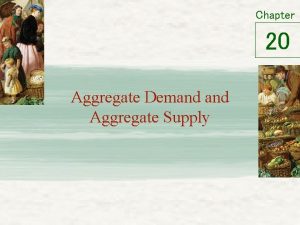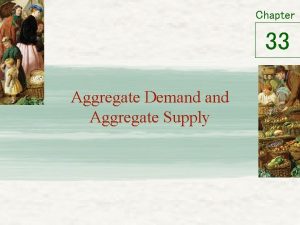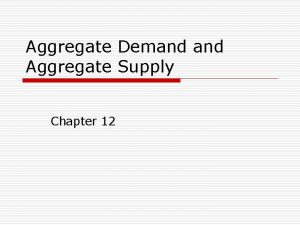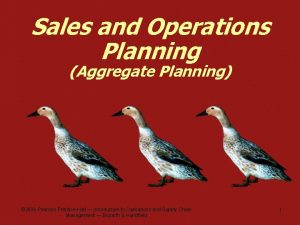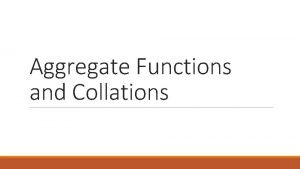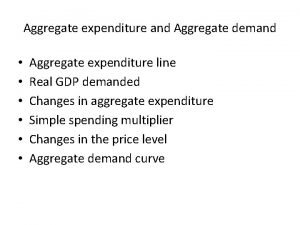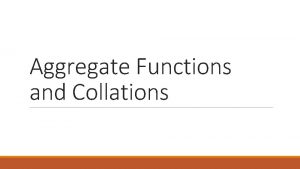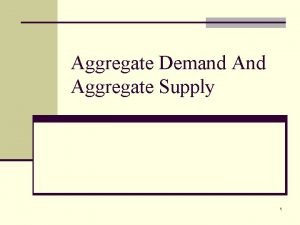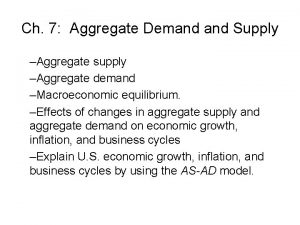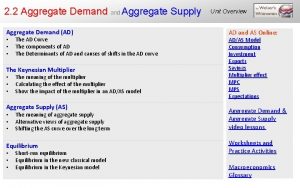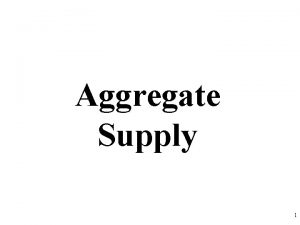Sales and Operations Planning Aggregate Planning Chapter 10










































- Slides: 42

Sales and Operations Planning (Aggregate Planning) Chapter 10

10 Chapter Objectives Be able to: § Distinguish among strategic planning, tactical planning, and detailed planning and control. § Describe why sales and operations planning (S&OP) is important to an organization and its supply chain partners. § Generate multiple alternative sales and operations plans for a firm. § Describe the differences between top-down and bottom-up S&OP and discuss the strengths and weaknesses of level, chase, and mixed production strategies. § Discuss the organizational issues that arise when firms decide to incorporate S&OP into their efforts. § Examine how S&OP can be used to coordinate activities up and down the supply chain. § Apply optimization modeling techniques to the S&OP process. Copyright © 2013 Pearson Education, Inc. publishing as Prentice Hall 10 - 2

10 Sales and Operations Planning § Sales and operations planning (S&OP) – A process to develop tactical plans by integrating marketing plans for new and existing products with the management of the supply chain. © 2010 APICS Dictionary § Brings together all the plans for the business into one integrated set of plans. § Also called Aggregate planning. Copyright © 2013 Pearson Education, Inc. publishing as Prentice Hall 10 - 3

10 S&OP Planning Levels § Strategic planning § Tactical planning § Detailed planning and control Figure 10. 1 Copyright © 2013 Pearson Education, Inc. publishing as Prentice Hall 10 - 4

10 Goals of S&OP § To indicate how the organization will use its tactical capacity resources to meet expected customer demand. § To strike a balance between the various needs and constraints of the supply chain partners. § To serve as a coordinating mechanism for the various supply chain partners. § To express the business’s plans in terms that everyone can understand. Copyright © 2013 Pearson Education, Inc. publishing as Prentice Hall 10 - 5

10 Major Approaches § Top-down planning – An approach to S&OP in which a single, aggregated sales forecast drives the planning process. § Bottom-up planning – An approach to S&OP that is used when the product/service mix is unstable and resource requirements vary greatly across the offerings. Copyright © 2013 Pearson Education, Inc. publishing as Prentice Hall 10 - 6

10 Choosing an Approach Figure 10. 2 Copyright © 2013 Pearson Education, Inc. publishing as Prentice Hall 10 - 7

10 Planning Values § Planning values – Values that decision makers use to translate a sales forecast into resource requirements and to determine the feasibility and costs of alternative sales and operations plans. Copyright © 2013 Pearson Education, Inc. publishing as Prentice Hall 10 - 8

10 Top-Down Planning § Developing a top-down plan: § Develop the aggregate sales forecast and planning values. § Translate the sales forecast into resource requirements. § Generate alternative production plans. Copyright © 2013 Pearson Education, Inc. publishing as Prentice Hall 10 - 9

10 Top-Down Example – Pennington Cabinets § 12 month sales forecast Copyright © 2013 Pearson Education, Inc. publishing as Prentice Hall 10 - 10

Top-Down Example – Pennington Cabinets 10 Table 10. 3 Copyright © 2013 Pearson Education, Inc. publishing as Prentice Hall 10 - 11

10 Top-Down Example – Pennington Cabinets § Forecast exceeds capacity in peak months Figure 10. 3 Copyright © 2013 Pearson Education, Inc. publishing as Prentice Hall 10 - 12

10 Top-Down Example – Pennington Cabinets § Translate the Sales Forecast into Resource Requirements For example: April 800 * 20 = 16, 000 hrs 16, 000/160 = 100 wkrs Table 10. 4 Copyright © 2013 Pearson Education, Inc. publishing as Prentice Hall 10 - 13

10 Alternative Production Plans § Level production plan – A S&OP plan in which production is held constant and inventory is used to absorb the differences between production and the sales forecast. § Chase production plan – A S&OP plan in which production is changed in each time period to match the sales forecast. § Mixed production plan - A S&OP plan that varies both production and inventory levels in an effort to develop the most effective plan. Copyright © 2013 Pearson Education, Inc. publishing as Prentice Hall 10 - 14

10 Level Production Plan Table 10. 5 Copyright © 2013 Pearson Education, Inc. publishing as Prentice Hall 10 - 15

10 Level Production Plan § Actual Workers § Hold workforce constant at 105 (average workforce over 12 -month planning horizon) § Regular Production § 105 x (160 hours per month/20 hours per set) = 840 sets per month or 10, 080 sets per year Copyright © 2013 Pearson Education, Inc. publishing as Prentice Hall 10 - 16

10 Level Production Plan § Hiring and Layoffs § Hire 5 workers in January to bring the workforce up to 105 from the initial level of 100. § Layoff 5 workers at the end to bring the workforce back to its starting level. • Ensures equal comparison of alternative plans under the same beginning and ending conditions. Copyright © 2013 Pearson Education, Inc. publishing as Prentice Hall 10 - 17

10 Level Production Plan § Inventory Levels Copyright © 2013 Pearson Education, Inc. publishing as Prentice Hall 10 - 18

10 Level Production Plan § Cost of the Plan Copyright © 2013 Pearson Education, Inc. publishing as Prentice Hall 10 - 19

10 Chase Production Plan § Actual workforce production and overtime production vary so that total production essentially matches sales for each month. § Inventory never builds up because total production “chases” sales. § There are more hires and layoffs and overtime production costs. Copyright © 2013 Pearson Education, Inc. publishing as Prentice Hall 10 - 20

10 Chase Production Plan Table 10. 6 Copyright © 2013 Pearson Education, Inc. publishing as Prentice Hall 10 - 21

10 Chase Production Plan § Cost of the plan Copyright © 2013 Pearson Education, Inc. publishing as Prentice Hall 10 - 22

10 Mixed Production Plan § By varying the production and inventory levels, the best plan can be developed. § The number of potential mixed plans is essentially limitless. § For example, overtime may be limited to 12 cabinet sets per month in October and November. Copyright © 2013 Pearson Education, Inc. publishing as Prentice Hall 10 - 23

10 Mixed Production Plan Table 10. 7 Copyright © 2013 Pearson Education, Inc. publishing as Prentice Hall 10 - 24

10 Mixed Production Plan § Cost of the Plan Copyright © 2013 Pearson Education, Inc. publishing as Prentice Hall 10 - 25

10 Bottom-Up Planning § Steps are similar to top-down planning. § Main difference is that the resource requirements for each product or service must be evaluated individually and then added up across all products or services to get a picture of overall requirements. Copyright © 2013 Pearson Education, Inc. publishing as Prentice Hall 10 - 26

10 Bottom-Up Example Table 10. 8 § Although machine hour requirements are similar, labor requirements differ greatly. Copyright © 2013 Pearson Education, Inc. publishing as Prentice Hall 10 - 27

10 Bottom-Up Example Table 10. 9 Copyright © 2013 Pearson Education, Inc. publishing as Prentice Hall 10 - 28

10 Bottom-Up Example § The difference in labor requirements becomes important when the product mix changes. § Even though the aggregate forecast across both product lines is 700 units each month, the product mix changes, as can be seen in the labor hours needed each month. Copyright © 2013 Pearson Education, Inc. publishing as Prentice Hall 10 - 29

10 Bottom-Up Example Load Profile – A display of future capacity requirements based on released and/or planned orders over a given span of time. © 2010 APICS Dictionary Figure 10. 4 Copyright © 2013 Pearson Education, Inc. publishing as Prentice Hall 10 - 30

10 Cash Flow Analysis § Net cash flow – The net flow of dollars into or out of a business over some time period. Net cash flow = cash inflows – cash outflows Copyright © 2013 Pearson Education, Inc. publishing as Prentice Hall 10 - 31

10 Cash Flow Analysis Different sales scenarios can have a significant effect on Figure 10. 5 cash flow as shown above. Copyright © 2013 Pearson Education, Inc. publishing as Prentice Hall 10 - 32

10 Choosing between Plans § What impact will the plan have on key suppliers and transportation providers? § What are the cash flows like? § Do the supply chain partners and the firm itself have the space needed to hold any planned inventories? § Does the plan contain significant changes in the workforce? § How flexible is the plan? Copyright © 2013 Pearson Education, Inc. publishing as Prentice Hall 10 - 33

10 Fine-Tuning the Plan Figure 10. 6 Copyright © 2013 Pearson Education, Inc. publishing as Prentice Hall 10 - 34

10 Rolling Planning Horizons § Rolling planning horizon – A planning approach in which an organization updates its sales and operations plan regularly, such as on a monthly or quarterly basis. Figure 10. 7 Copyright © 2013 Pearson Education, Inc. publishing as Prentice Hall 10 - 35

10 Implementing S&OP § Developing the foundation § Build managerial support and infrastructure to make it a success. § Integrating and streamlining the process § Update the plan and use the results for decisionmaking. § Gaining a competitive advantage § Make S&OP a core competency. Copyright © 2013 Pearson Education, Inc. publishing as Prentice Hall 10 - 36

10 Service Considerations § Making sales match capacity § Making capacity (typically the workforce) match sales Copyright © 2013 Pearson Education, Inc. publishing as Prentice Hall 10 - 37

10 Making Sales Match Capacity § Yield management – An approach that services commonly use with highly perishable “products” in which prices are regularly adjusted to maximize total profit. Total profit = (average profit per service unit sold) * (# of service units sold) Copyright © 2013 Pearson Education, Inc. publishing as Prentice Hall 10 - 38

10 Making Capacity Match Sales § Tiered workforce – A strategy used to vary workforce levels in which additional full-time or part-time employees are hired during peak demand periods, while a smaller permanent staff is maintained year-round. § Offloading – A strategy for reducing and smoothing out workforce requirements that involves having customers perform part of the work themselves. Copyright © 2013 Pearson Education, Inc. publishing as Prentice Hall 10 - 39

10 S&OP Optimization Modeling § Optimization model – A class of mathematical models used when the user seeks to optimize some objective function subject to some constraints. § Understand the pattern of resource decisions – labor, inventory, machine time, etc. - that will result in the lowest total cost while still meeting the sales forecast. Copyright © 2013 Pearson Education, Inc. publishing as Prentice Hall 10 - 40

Sales and Operations Planning Case Study Covolo Diving Gear, Part 2 Copyright © 2013 Pearson Education, Inc. publishing as Prentice Hall 10 -

All rights reserved. No part of this publication may be reproduced, stored in a retrieval system, or transmitted, in any form or by any means, electronic, mechanical, photocopying, recording, or otherwise, without the prior written permission of the publisher. Printed in the United States of America. Copyright © 2013 Pearson Education, Inc. publishing as Prentice Hall 10 - 42
 Aggregate planning excel solver
Aggregate planning excel solver Aggregate planning
Aggregate planning Sras lras
Sras lras Aggregate planning operations management
Aggregate planning operations management Ad curve graph
Ad curve graph How to mix aggregate and non aggregate tableau
How to mix aggregate and non aggregate tableau Aggregate supply shifters
Aggregate supply shifters Unit 3 aggregate demand aggregate supply and fiscal policy
Unit 3 aggregate demand aggregate supply and fiscal policy Unit 3 aggregate demand aggregate supply and fiscal policy
Unit 3 aggregate demand aggregate supply and fiscal policy Sap sales and operations planning ppt
Sap sales and operations planning ppt Rough cut capacity planning example
Rough cut capacity planning example Aggregate planning is capacity planning for:
Aggregate planning is capacity planning for: Aggregate planning is capacity planning for
Aggregate planning is capacity planning for Capacity aggregation example
Capacity aggregation example Chase strategy in aggregate planning
Chase strategy in aggregate planning Aggregate production planning strategies
Aggregate production planning strategies Inputs and outputs of aggregate planning
Inputs and outputs of aggregate planning S&op powerpoint presentation
S&op powerpoint presentation Disaggregating an aggregate plan leads to a master schedule
Disaggregating an aggregate plan leads to a master schedule Sales force organization structure
Sales force organization structure Discuss the nuances of sales letters.
Discuss the nuances of sales letters. Sales organization structures
Sales organization structures Management of sales territories and quotas
Management of sales territories and quotas The strategy
The strategy Chase vs level strategy
Chase vs level strategy Aggregate planning in supply chain
Aggregate planning in supply chain Aggregate planning
Aggregate planning Aggregate planning formula
Aggregate planning formula Transportation method of aggregate planning
Transportation method of aggregate planning Disaggregate planning
Disaggregate planning Aggregate planning
Aggregate planning Chase strategy example
Chase strategy example Types of plans in management
Types of plans in management Sales potential vs sales forecast
Sales potential vs sales forecast Which is the primary sales tool in most operations?
Which is the primary sales tool in most operations? Site:slidetodoc.com
Site:slidetodoc.com Aggregate demand supply graph
Aggregate demand supply graph Aggregate supply shocks
Aggregate supply shocks Aggregate of chapter 6
Aggregate of chapter 6 Types of sales planning
Types of sales planning Location planning in operations management
Location planning in operations management What is the strategic plan and analysis of retailing?
What is the strategic plan and analysis of retailing? Sales call steps
Sales call steps
